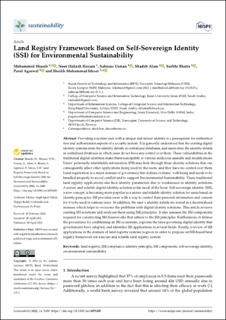| dc.contributor.author | Shuaib, Mohammed | |
| dc.contributor.author | Hassan, Noor Hafizah | |
| dc.contributor.author | Usman, Sahnius | |
| dc.contributor.author | Alam, Shadab | |
| dc.contributor.author | Bhatia, Surbhi | |
| dc.contributor.author | Agarwal, Parul | |
| dc.contributor.author | Sheikh, Mohammad Idrees | |
| dc.date.accessioned | 2023-02-02T08:08:51Z | |
| dc.date.available | 2023-02-02T08:08:51Z | |
| dc.date.created | 2022-10-10T18:05:25Z | |
| dc.date.issued | 2022 | |
| dc.identifier.citation | Sustainability. 2022, 14 (9), . | en_US |
| dc.identifier.issn | 2071-1050 | |
| dc.identifier.uri | https://hdl.handle.net/11250/3047866 | |
| dc.description.abstract | Providing a system user with a unique and secure identity is a prerequisite for authentication and authorization aspects of a security system. It is generally understood that the existing digital identity systems store the identity details in centralized databases, and users store the identity details in centralized databases in which users do not have any control over them. These vulnerabilities in the traditional digital identities make them susceptible to various malicious assaults and modifications. Users’ personally identifiable information (PII) may leak through these identity solutions that can consequently affect other applications being used by the users, and they have no control over them. Land registration is a major domain of governance that defines civilians’ well-being and needs to be handled properly to avoid conflict and to support Environmental Sustainability. These traditional land registry applications also lack identity parameters due to weaknesses in identity solutions. A secure and reliable digital identity solution is the need of the hour. Self-sovereign identity (SSI), a new concept, is becoming more popular as a secure and reliable identity solution for users based on identity principles. SSI provides users with a way to control their personal information and consent for it to be used in various ways. In addition, the user’s identity details are stored in a decentralized manner, which helps to overcome the problems with digital identity solutions. This article reviews existing SSI solutions and analyzes them using SSI principles. It also assesses the SSI components required for constructing SSI frameworks that adhere to the SSI principles. Furthermore, it defines the procedures for establishing an SSI ecosystem, explores the laws governing digital identity that governments have adopted, and identifies SSI applications in several fields. Finally, a review of SSI applications in the domain of land registry systems is given in order to propose an SSI-based land registry framework for a secure and reliable land registry system. | en_US |
| dc.language.iso | eng | en_US |
| dc.publisher | MDPI | en_US |
| dc.rights | Navngivelse 4.0 Internasjonal | * |
| dc.rights.uri | http://creativecommons.org/licenses/by/4.0/deed.no | * |
| dc.title | Land Registry Framework Based on Self-Sovereign Identity (SSI) for Environmental Sustainability | en_US |
| dc.title.alternative | Land Registry Framework Based on Self-Sovereign Identity (SSI) for Environmental Sustainability | en_US |
| dc.type | Peer reviewed | en_US |
| dc.type | Journal article | en_US |
| dc.description.version | publishedVersion | en_US |
| dc.source.pagenumber | 0 | en_US |
| dc.source.volume | 14 | en_US |
| dc.source.journal | Sustainability | en_US |
| dc.source.issue | 9 | en_US |
| dc.identifier.doi | 10.3390/su14095400 | |
| dc.identifier.cristin | 2060199 | |
| cristin.ispublished | true | |
| cristin.fulltext | original | |
| cristin.qualitycode | 1 | |

